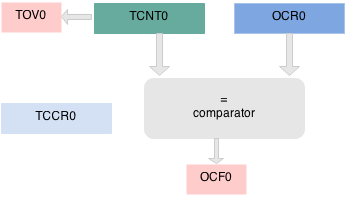Difference between revisions of "AVR Timer programming"
| Line 10: | Line 10: | ||
=Timers/Counters in AVR= | =Timers/Counters in AVR= | ||
==Timer 0== | ==Timer 0== | ||
| + | |||
[[File:Timer 0.png|center]] | [[File:Timer 0.png|center]] | ||
| + | {| class="wikitable floatright" style="float:right; background-color:#87A96B;" | ||
| + | |- | ||
| + | !colspan = '8'|SCON | ||
| + | |- | ||
| + | |D7||D6||D5||D4||D3||D2||D1||D0 | ||
| + | |- | ||
| + | |SM0||SM1||SM2||REN||TB8||RB8||TI||RI | ||
| + | |} | ||
==Timer 1== | ==Timer 1== | ||
==Timer 2== | ==Timer 2== | ||
Revision as of 12:06, 18 November 2014
Basics
Timers come in handy when you want to set some time interval like your alarm. This can be very precise to a few microseconds. Timers/Counters are essential part of any modern MCU. Remember it is the same hardware unit inside the MCU that is used either as Timers or Counter. Timers/counters are an independent unit inside a micro-controller. They basically run independently of what task CPU is performing. Hence they come in very handy, and are primarily used for the following:
- Internal Timer: As an internal timer the unit, ticks on the oscillator frequency. The oscillator frequency can be directly feed to the timer or it can be pre-scaled. In this mode it used generate precise delays. Or as precise time counting machine.
- External Counter: In this mode the unit is used to count events on a specific external pin on a MCU.
- Pulse width Modulation(PWM) Generator: PWM is used in speed control of motors and various other applications.
Timers/Counters in AVR
Timer 0
| SCON | |||||||
|---|---|---|---|---|---|---|---|
| D7 | D6 | D5 | D4 | D3 | D2 | D1 | D0 |
| SM0 | SM1 | SM2 | REN | TB8 | RB8 | TI | RI |


